Vlatka Horvat’s collaged landscapes
With a daily project over the whole of 2021, multimedia artist Vlatka Horvat looks and looks again at her immediate surroundings, using the experience of lockdown to create playful analogue collages reimagining her everyday urban experiences. Alongside, at PEER gallery, she shows sculptural and video work in a show exploring how we exist in space.
Recessed.space met artist Vlatka Horvat just before her new
exhibition, By Hand, on Foot, opened at PEER gallery, Hoxton. Horvat started
her artistic journey working in performance, but has expanded her repertoire of
mediums in work considering our spatial and social relationship to landscapes
around us, with this show incorporating photographic collage, site-specific
sculptures, and a video work.
Central to the exhibition is a series of 365 photographic collages, one made each day over 2021. The year started in a lockdown, and Horvat had got into the habit of a morning walk with her partner around a field in North London, and that engagement with her local neighbourhood triggered a new project, about looking, speculation, and pushing at the edges of the everyday.
![]()
![]()
In 2020 everything was online, and as we were going into 2021 I wanted to give myself a frame that would require me to do something away from the screen every day. I wanted to do a year-long project that would involve making something with my hands. Since the first lockdown in 2020 my partner and I have been walking every day around a field near our house. We were super lucky that we had this big urban greenspace where you feel like you're outside of the city when you go there. And I wanted to connect the project to a daily activity I was already doing. So those two things combined is where the idea for the project came from.
I often work with self-imposed systems of rules and frameworks that I create for myself within which I then improvise and try to find the edges of the system. For this project I gave myself this framework: every day on the walk I would take a photo of the landscape, mostly devoid of people, and then at home I’d print it and intervene in the image in various ways, drawing on it, ripping the paper, reorganising the image and so on. There was a sub-rule - related to my work more broadly – that whatever I did to the image had to come from the image. I have a kind of toolbox of strategies when working with images and spaces, one of which is repeating what's already there. I would always try to find something in the image I could either alter, repeat or multiply. Or kind of amplify.
![]()
![]()
Were you're thinking of that at the moment of taking the photo? Or were you treating them as distinct creative acts?
Over the course of the year it changed, and from day to day it changed. What I was interested in with the work was that it was very much about looking. This idea of looking, repeated looking, and looking over and over again, at the same place. There’s something related to George Perec in it in terms of trying to exhaust a place by looking at it, and looking at it again. I’m interested in these two forms of looking: the first one being looking while in motion, while inhabiting a space or traversing through a landscape, looking in four-dimensional space; and then the second one, a looking at that same world once it's become a picture. I think about how you see things differently when you're present, compared to once you’re removed through representation.
Did you change your rules at all?
I didn’t change the rules, but one of the things the work did inadvertently - as well as being a diary of sorts - was also to become a reflection on the world at large in terms of what was happening in that year. The first six months was the lockdown, which really framed the work, because first six months I was looking at only this field – since we weren't travelling, I wasn't going anywhere on the tube or a bus, it was really living solely in the neighbourhood. So I was working with this very, very ultra-local idea of the ordinary, looking at things close by. I think what that did is help me tune into the minutiae of what's around in a very local way.
When the lockdown was lifted around July, I went to see my parents in Croatia. I had a moment of thinking, “I wonder if the project will sustain a change?”, because after six months it became just about thisfield. But I kept doing the project, using the same rules in a different location.
At that point I decided that every time I would travel for the rest of the year, that day’s work would be the picture of the airport, or the train station, or a picture taken from the plane, so that it signalled a change in location. Otherwise you’d be in this field one day, and then suddenly you're in Croatia, and I wanted to mark somehow a change of location.
![]()
![]()
fig.v, vi
And over the first six months walking a place which you were already so familiar with - and now even more familiar with - if you were to go for a walk today, do you see these places differently? For instance, can you now not see specific locations without also seeing your creative reimaginings?
I think that's what's really interesting, somehow these things I enacted on representation, it’s almost like they now exist in some dimension of the space that is invisible. These interventions I’ve enacted on images do somehow alter future experiences, almost like they've made a kind of mark on places.
This is something in architecture also - any architect who has speculatively designed or entered a competition, but which never got made or event left the paper, it can still forever exist in their understanding of the site.
That's interesting, because I do think of this work in terms of proposals – as a kind of a map of both plausible or impossible proposals for change, for transforming a place. From day to day, there's no consistency to the transformations being proposed, so some days you think, “oh, that could actually work”, and other days it moves into some register of fantasy, science-fiction or dystopia. Its registers shift from apparently useful ideas for the world, and preposterous or silly ones.
![]()
![]()
![]()
I see in some of the collages hints of radical utopian ideas of the 60s, where both artists and architects created propositions like this, as montage both half-true and half-not, somewhere in that soft boundary between proposal and speculation. You also have developed the works into a publication, with an essay written by Lauren Elkin.
I had read Lauren’s book Flâneuse some years ago. Then I came across her new book written on Paris bus journeys, No. 91/92, and there was a kind of conversation between the two of our projects. There were a lot of connecting points, and she also writes a lot about Georges Perec, this idea of the ordinary and the focus on looking, looking more stupidly.
Which is in your videos as well, talking about stupidly, there’s something Fluxus about them, with seemingly absurd rules of movement which aren’t quite explained.
I guess there is an insistence there in the work, focused on repeating a gesture or a strategy or an image or an object – repetition itself often giving rise to other attempts at doing the same thing. But the reason for doing something again is not explained; whether it's because the previous attempt was inadequate or not, why repetition has to continue – it’s decidedly left unexplained.
There’s also the idea of measuring. In your video work there is a motif of placing an object on the ground as if to measure movement, knowingly inaccurate.
It’s a preoccupation in my work - this attempt to figure out how to relate to the world and to the frames in which we live and function, whether they're architecture and the city, or political systems. You're always trying to kind of position yourself in relation to these frames, and that's a kind of measuring - having to orientate yourself in spatial and temporal frameworks, constantly taking a measure of where you are and newly positioning oneself. That’s something in my work that I return to – a certain fraught relationship to built space, to the city, landscape, architecture, and our attempts to push against it.
![]()
![]()
Which your sculptures here do as well, literally pushing against the ceiling but also functioning as measuring sticks as if surveying a site.
It’s as if they are taking a measure of the room from the top to the bottom. But I'm also interested in creating a space in its own right, an environment if you will, something potentially fantastical, as well as having a metaphorical resonance, hinting at going past the limit, an aspiration upwards, through a verticality drawing towards the sky.
Like your collage turning a suburban house into a Jenga tower? Which even leaves the frame of the photograph itself.
Something which comes up repeatedly in the series To See Sky over Mountains is an attempt to escape the frame of the image. In my work there is always an attempt to somehow imaginatively dismantle or draw attention to the boundary of architectural space. I'm very interested in putting things on the edges - in the sculptural work, for example, things are often on the periphery, as opposed to in the middle.
![]()
![]()
![]()
![]()
Which is the space artists occupy.
We often think of architecture as a thing that's there in a very non-negotiable way, but it comes down very easily, it’s dismantled very easily, not only with decay, falling apart over time, but also deliberate acts of bringing it down - its solidity is just temporary.
In one of your collages you seem to trace the outline of buildings which aren't there, which look almost as if they are a planning application for towers showing height and shadowing.
Sometimes, on a very foggy day, I had that moment of, “is there a building there? Or not?” Sometimes things play tricks with your vision, and you're not sure what you're looking at. The work is then trying to amplify that feeling of ghostliness of buildings in the distance or fog. Both there and not there.
That’s something you play with in montage anyway. You declare there is a difference of images, you show the joint, it’s not like a smooth digital joining. But often images uncannily lock together.
It’s important to me it's not a seamless change, that the intervention is visible and looks self-declared, that there's a kind of fraughtness or tension between what's been done and what was there before. So the gesture wears its inadequacy or intervention on its sleeve, maybe inviting you to imagine how it was before.
![]()
![]()
![]()
![]()
This is something relevant to architecture. In digital creation, anybody can come up with an idea for a building, and very quickly can create an immaculate render which looks real, like a photo. But often a sketch or model would be more truthful, opening up more opportunities.
Sometimes, on a very foggy day, I had that moment of, “is there a building there? Or not?” Sometimes things play tricks with your vision, and you're not sure what you're looking at. The work is then trying to amplify that feeling of ghostliness of buildings in the distance or fog. Both there and not there.
There are three parts to your exhibition – the photographic collages, sculpture, and video. How do you think they talk to each other?
The logic of the sculptural piece responds to the room. It's quite a tricky space in many ways, the windows dominate, and I wanted to make something which follows the logic of the collages, mirroring and repeating what is already there. So I use the windows to mirror in the room what is outside. Some of the structures are a kind of an inadequate attempt to remake what’s on the outside of the window – a bike lockup of metal loops, the verticals of trees and lampposts, a proliferation of cylindrical garbage cans. The starting point was again looking, but in this case looking outward, and trying to remake things.
So a translation from mundane physicality to art object.
From a real state to its representation, but a morphed and degraded one. In the same way there are two kinds of looking in the collages - looking in the world while walking, then looking into an image – there is something similar going on with an attempt to create a three dimensional image, an attempt to make a picture of what's outside.
![]()
So, the opposite direction to how designers of the world work – they imagine something, draw it, then make it – whether building, object or street…
The installation started from looking at what's outside, but then forms repeat inside the room through proliferation or degradation. The starting point is trying to remake something I see, and then the forms produce their own logic which I follow. Maybe there's a searchfor something in this process, with repetition in general, when you do something over and over again.
There's something about escape. Your collages are trying to leave the frame, the sculptures seem like they are trying to push through the ceiling, and though we may love the streets or parks near our home, in lockdown we yearned for escape.
I think this is probably the case with any sort of repetition or routine that we have in the way we organise our lives, we like them - but also want to get away from them.
![]()
![]()
Central to the exhibition is a series of 365 photographic collages, one made each day over 2021. The year started in a lockdown, and Horvat had got into the habit of a morning walk with her partner around a field in North London, and that engagement with her local neighbourhood triggered a new project, about looking, speculation, and pushing at the edges of the everyday.
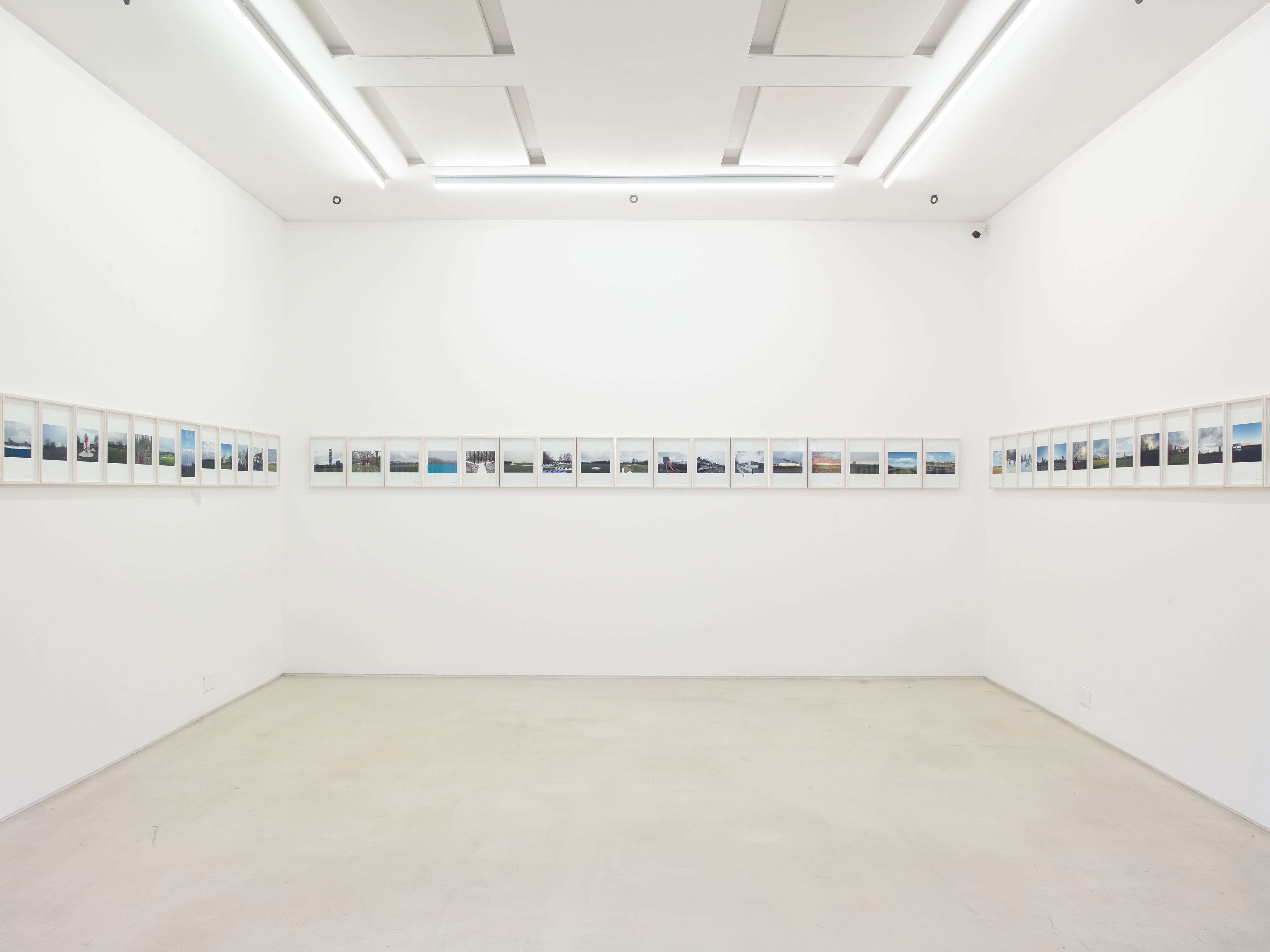
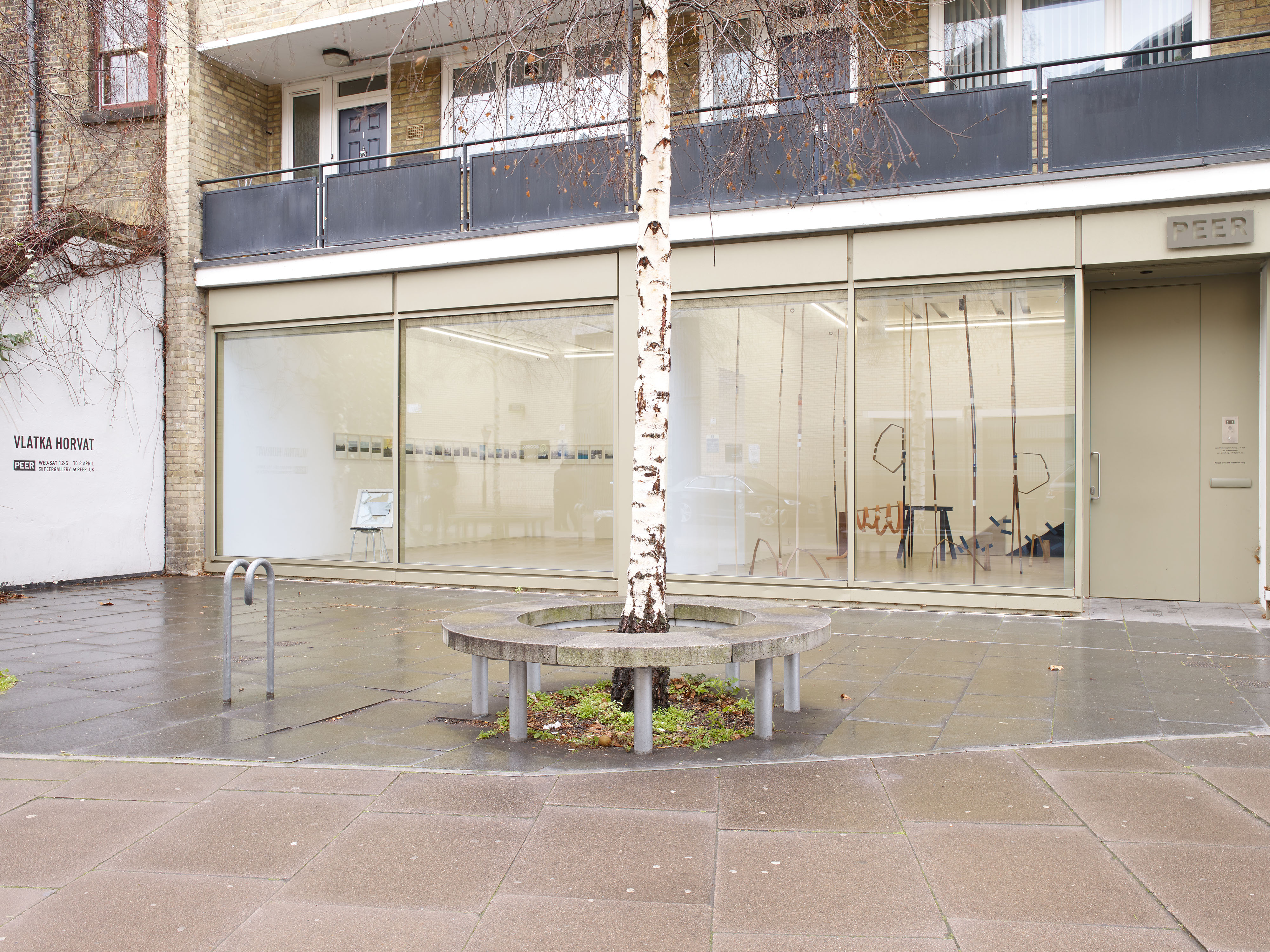
fig.i, ii
We started by asking Horvat about how this project began:
In 2020 everything was online, and as we were going into 2021 I wanted to give myself a frame that would require me to do something away from the screen every day. I wanted to do a year-long project that would involve making something with my hands. Since the first lockdown in 2020 my partner and I have been walking every day around a field near our house. We were super lucky that we had this big urban greenspace where you feel like you're outside of the city when you go there. And I wanted to connect the project to a daily activity I was already doing. So those two things combined is where the idea for the project came from.
I often work with self-imposed systems of rules and frameworks that I create for myself within which I then improvise and try to find the edges of the system. For this project I gave myself this framework: every day on the walk I would take a photo of the landscape, mostly devoid of people, and then at home I’d print it and intervene in the image in various ways, drawing on it, ripping the paper, reorganising the image and so on. There was a sub-rule - related to my work more broadly – that whatever I did to the image had to come from the image. I have a kind of toolbox of strategies when working with images and spaces, one of which is repeating what's already there. I would always try to find something in the image I could either alter, repeat or multiply. Or kind of amplify.

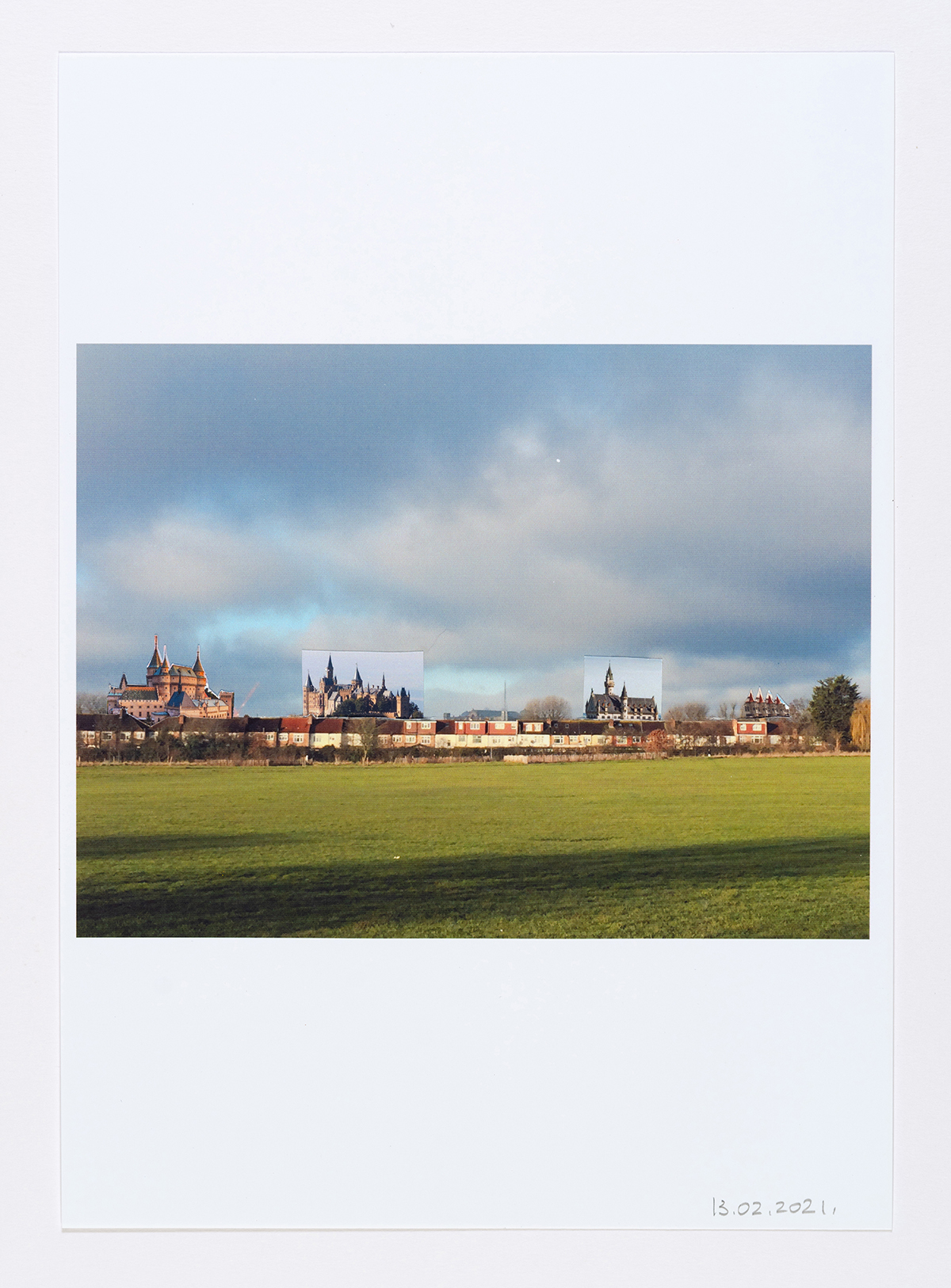
fig.iii, iv
Were you're thinking of that at the moment of taking the photo? Or were you treating them as distinct creative acts?
Over the course of the year it changed, and from day to day it changed. What I was interested in with the work was that it was very much about looking. This idea of looking, repeated looking, and looking over and over again, at the same place. There’s something related to George Perec in it in terms of trying to exhaust a place by looking at it, and looking at it again. I’m interested in these two forms of looking: the first one being looking while in motion, while inhabiting a space or traversing through a landscape, looking in four-dimensional space; and then the second one, a looking at that same world once it's become a picture. I think about how you see things differently when you're present, compared to once you’re removed through representation.
Did you change your rules at all?
I didn’t change the rules, but one of the things the work did inadvertently - as well as being a diary of sorts - was also to become a reflection on the world at large in terms of what was happening in that year. The first six months was the lockdown, which really framed the work, because first six months I was looking at only this field – since we weren't travelling, I wasn't going anywhere on the tube or a bus, it was really living solely in the neighbourhood. So I was working with this very, very ultra-local idea of the ordinary, looking at things close by. I think what that did is help me tune into the minutiae of what's around in a very local way.
When the lockdown was lifted around July, I went to see my parents in Croatia. I had a moment of thinking, “I wonder if the project will sustain a change?”, because after six months it became just about thisfield. But I kept doing the project, using the same rules in a different location.
At that point I decided that every time I would travel for the rest of the year, that day’s work would be the picture of the airport, or the train station, or a picture taken from the plane, so that it signalled a change in location. Otherwise you’d be in this field one day, and then suddenly you're in Croatia, and I wanted to mark somehow a change of location.
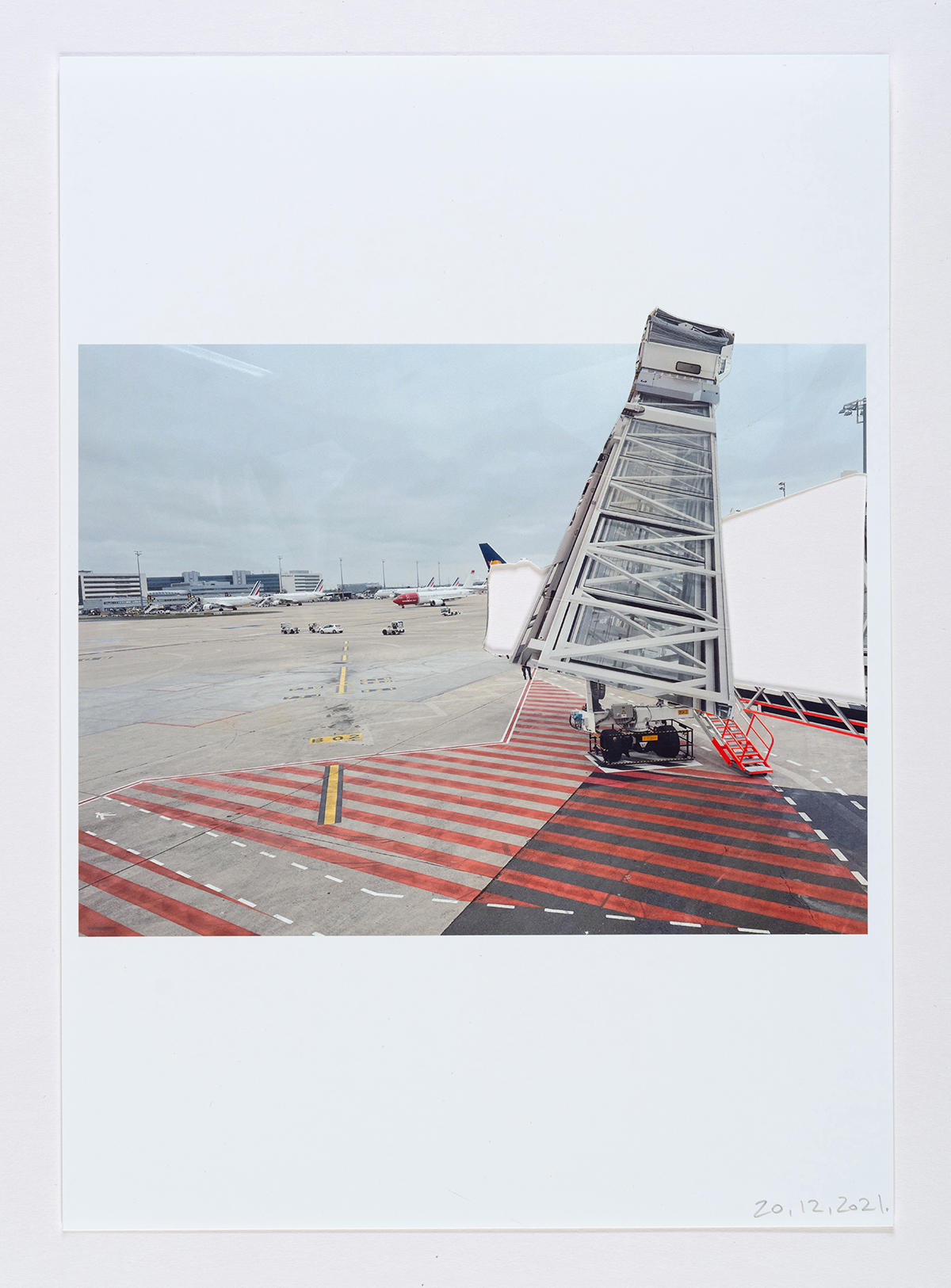

fig.v, vi
And over the first six months walking a place which you were already so familiar with - and now even more familiar with - if you were to go for a walk today, do you see these places differently? For instance, can you now not see specific locations without also seeing your creative reimaginings?
I think that's what's really interesting, somehow these things I enacted on representation, it’s almost like they now exist in some dimension of the space that is invisible. These interventions I’ve enacted on images do somehow alter future experiences, almost like they've made a kind of mark on places.
This is something in architecture also - any architect who has speculatively designed or entered a competition, but which never got made or event left the paper, it can still forever exist in their understanding of the site.
That's interesting, because I do think of this work in terms of proposals – as a kind of a map of both plausible or impossible proposals for change, for transforming a place. From day to day, there's no consistency to the transformations being proposed, so some days you think, “oh, that could actually work”, and other days it moves into some register of fantasy, science-fiction or dystopia. Its registers shift from apparently useful ideas for the world, and preposterous or silly ones.
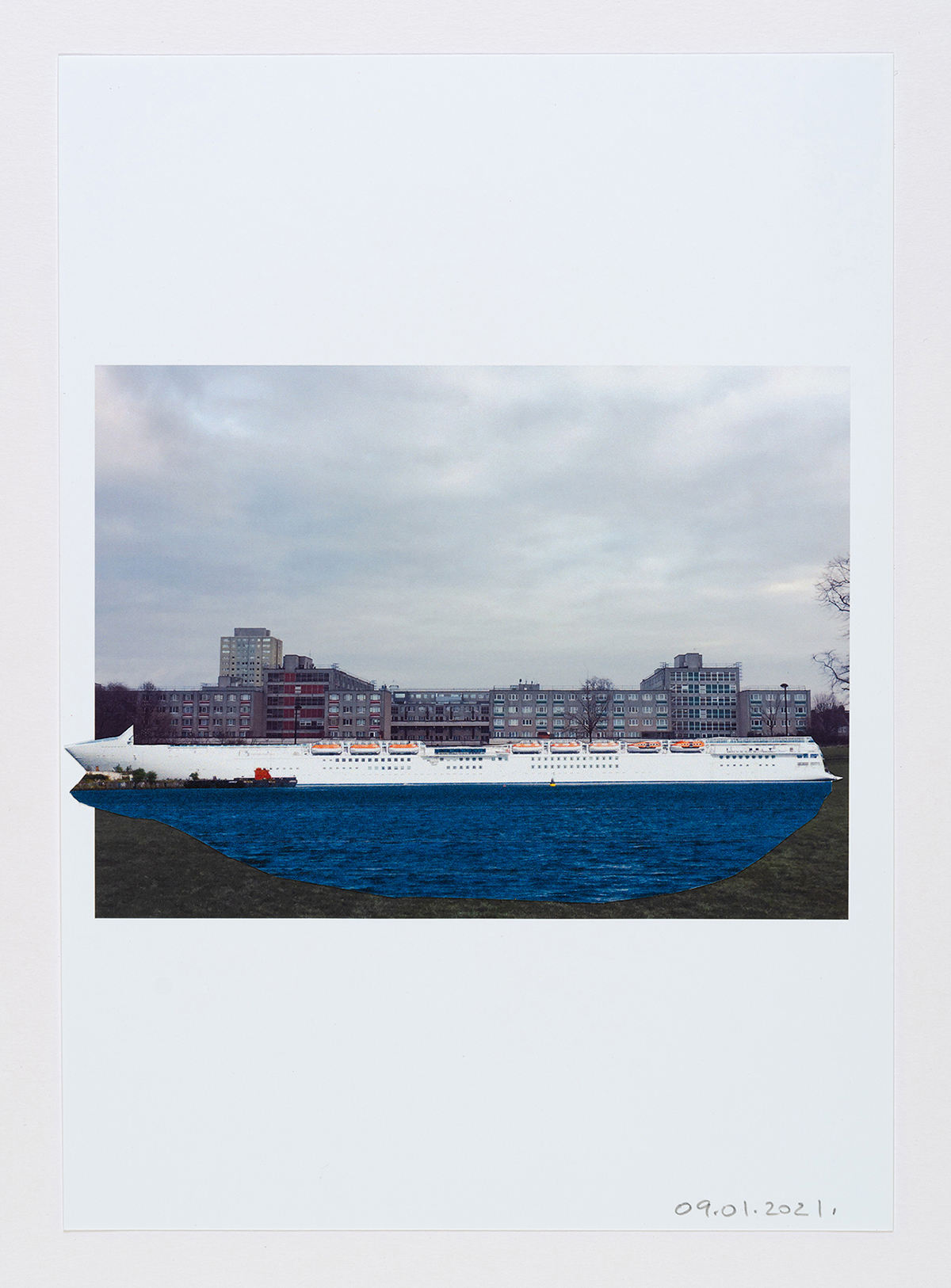
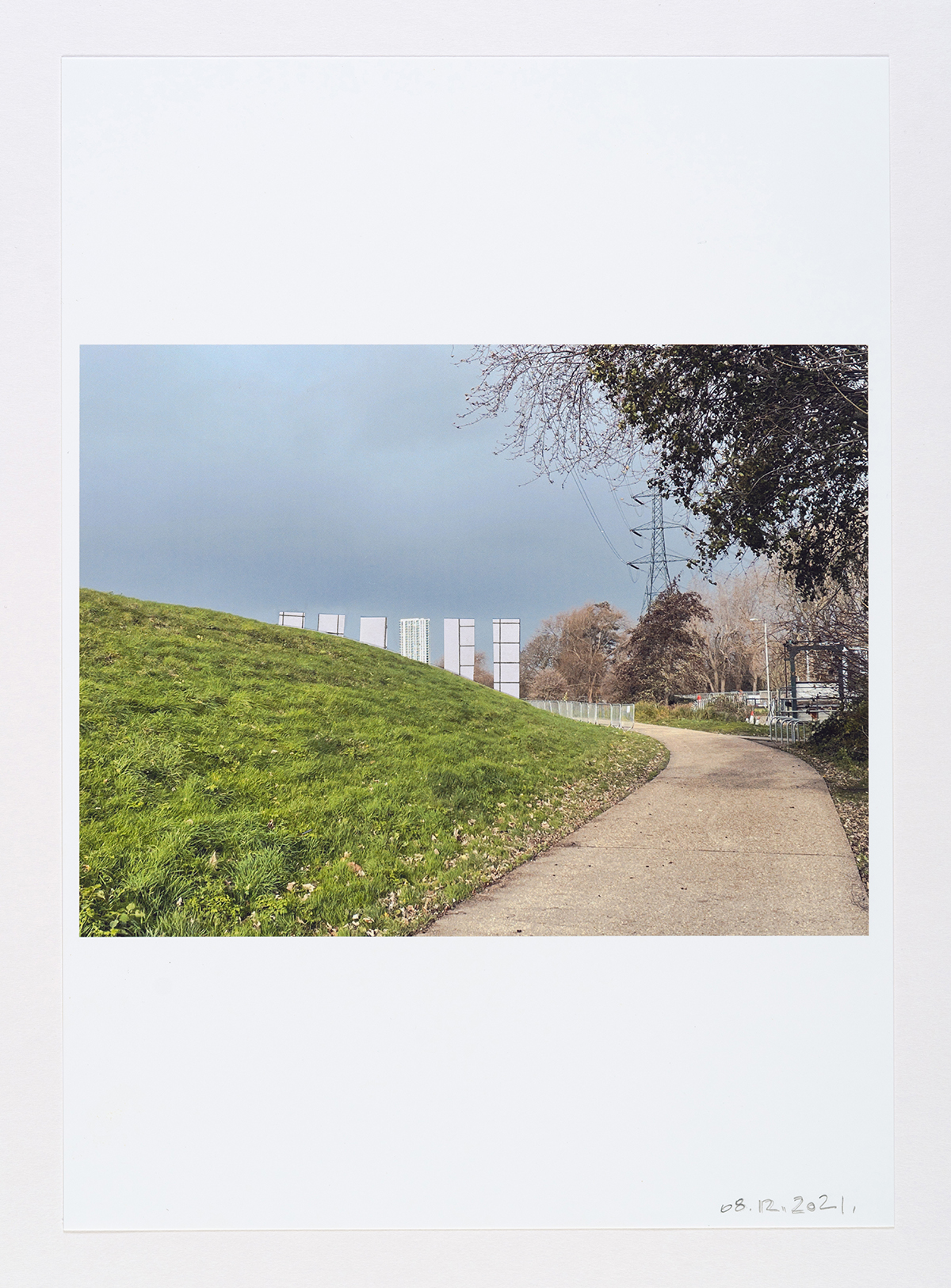
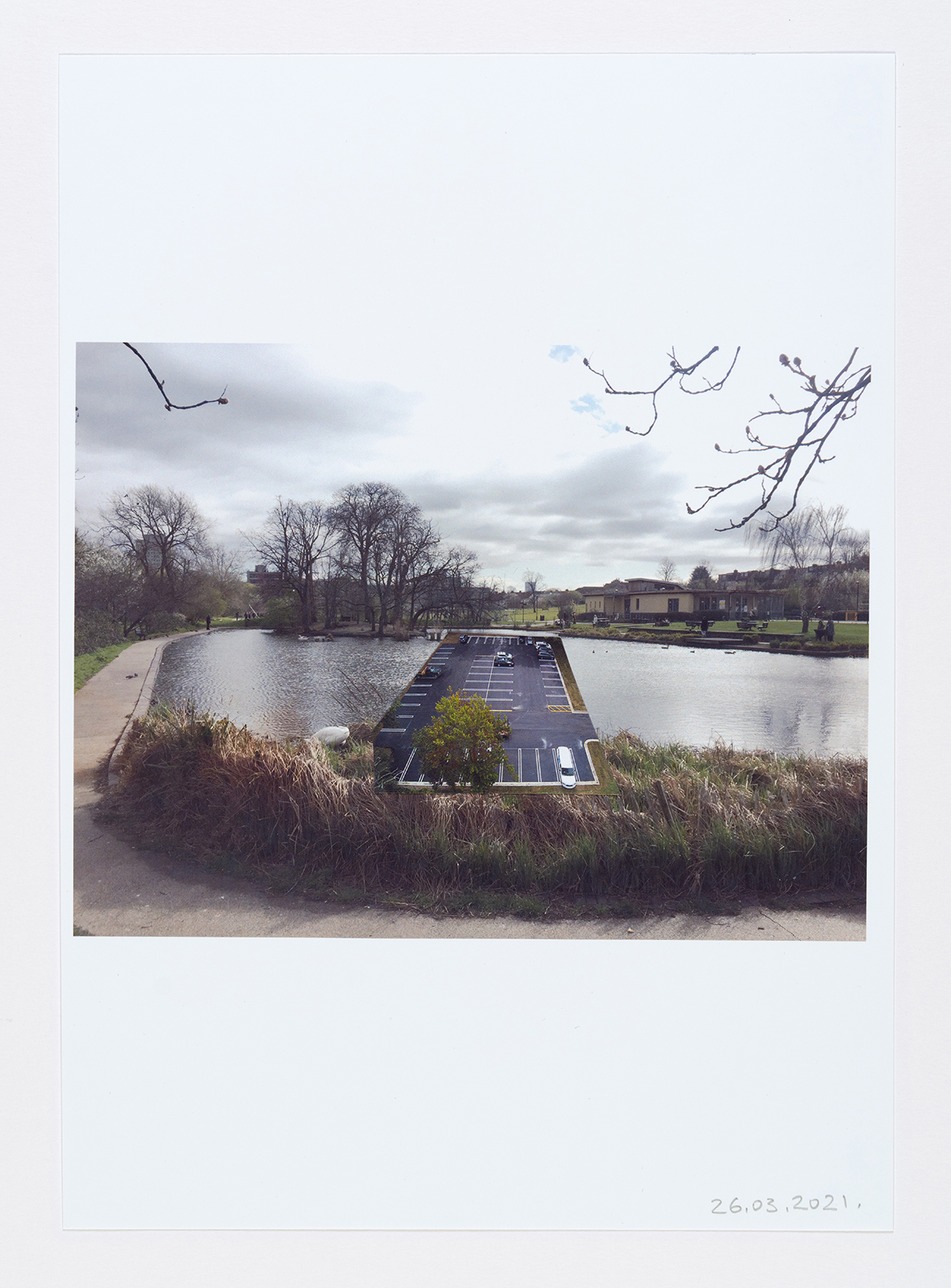
fig.vii-ix
I see in some of the collages hints of radical utopian ideas of the 60s, where both artists and architects created propositions like this, as montage both half-true and half-not, somewhere in that soft boundary between proposal and speculation. You also have developed the works into a publication, with an essay written by Lauren Elkin.
I had read Lauren’s book Flâneuse some years ago. Then I came across her new book written on Paris bus journeys, No. 91/92, and there was a kind of conversation between the two of our projects. There were a lot of connecting points, and she also writes a lot about Georges Perec, this idea of the ordinary and the focus on looking, looking more stupidly.
Which is in your videos as well, talking about stupidly, there’s something Fluxus about them, with seemingly absurd rules of movement which aren’t quite explained.
I guess there is an insistence there in the work, focused on repeating a gesture or a strategy or an image or an object – repetition itself often giving rise to other attempts at doing the same thing. But the reason for doing something again is not explained; whether it's because the previous attempt was inadequate or not, why repetition has to continue – it’s decidedly left unexplained.
There’s also the idea of measuring. In your video work there is a motif of placing an object on the ground as if to measure movement, knowingly inaccurate.
It’s a preoccupation in my work - this attempt to figure out how to relate to the world and to the frames in which we live and function, whether they're architecture and the city, or political systems. You're always trying to kind of position yourself in relation to these frames, and that's a kind of measuring - having to orientate yourself in spatial and temporal frameworks, constantly taking a measure of where you are and newly positioning oneself. That’s something in my work that I return to – a certain fraught relationship to built space, to the city, landscape, architecture, and our attempts to push against it.
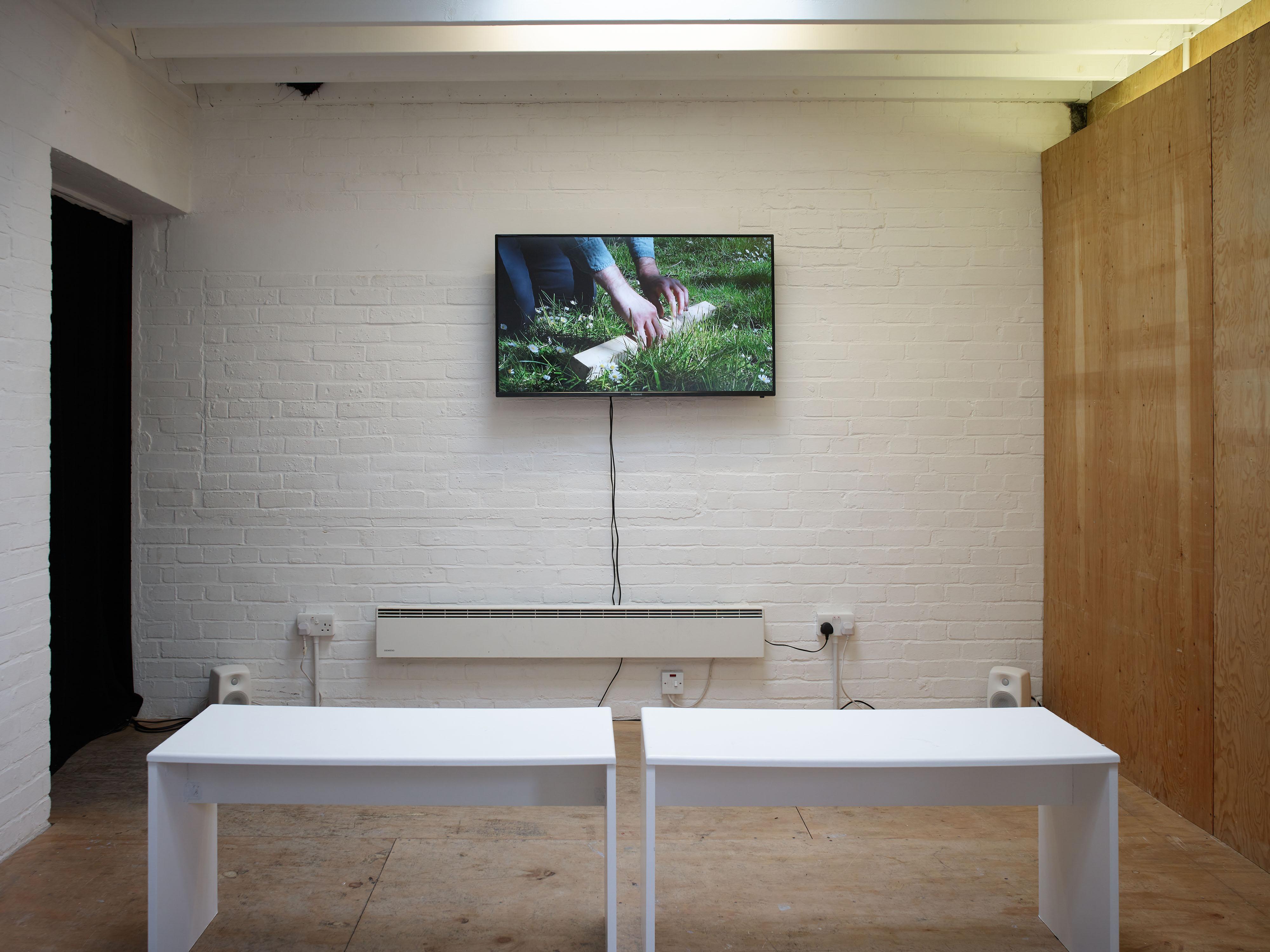
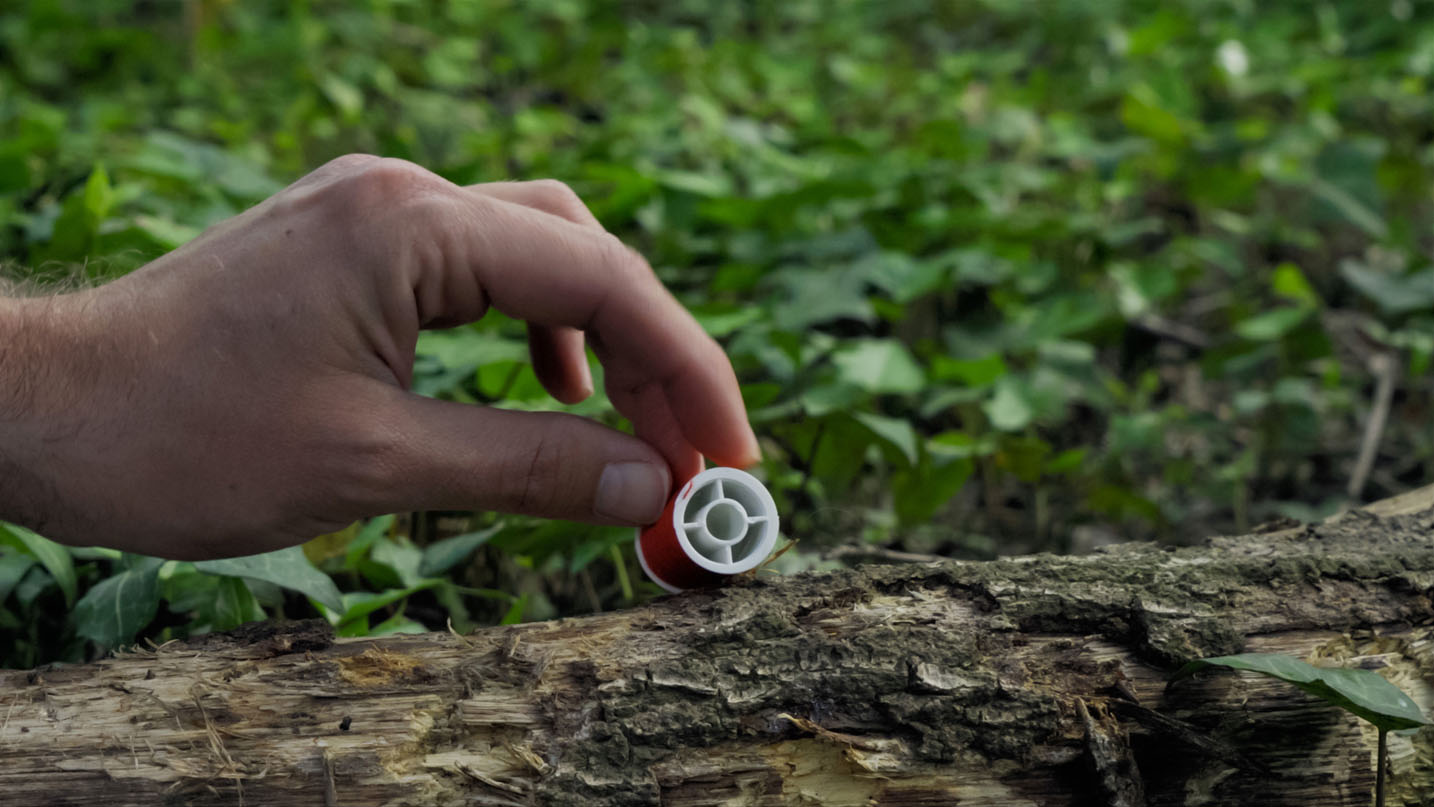
fig.x, xi
Which your sculptures here do as well, literally pushing against the ceiling but also functioning as measuring sticks as if surveying a site.
It’s as if they are taking a measure of the room from the top to the bottom. But I'm also interested in creating a space in its own right, an environment if you will, something potentially fantastical, as well as having a metaphorical resonance, hinting at going past the limit, an aspiration upwards, through a verticality drawing towards the sky.
Like your collage turning a suburban house into a Jenga tower? Which even leaves the frame of the photograph itself.
Something which comes up repeatedly in the series To See Sky over Mountains is an attempt to escape the frame of the image. In my work there is always an attempt to somehow imaginatively dismantle or draw attention to the boundary of architectural space. I'm very interested in putting things on the edges - in the sculptural work, for example, things are often on the periphery, as opposed to in the middle.
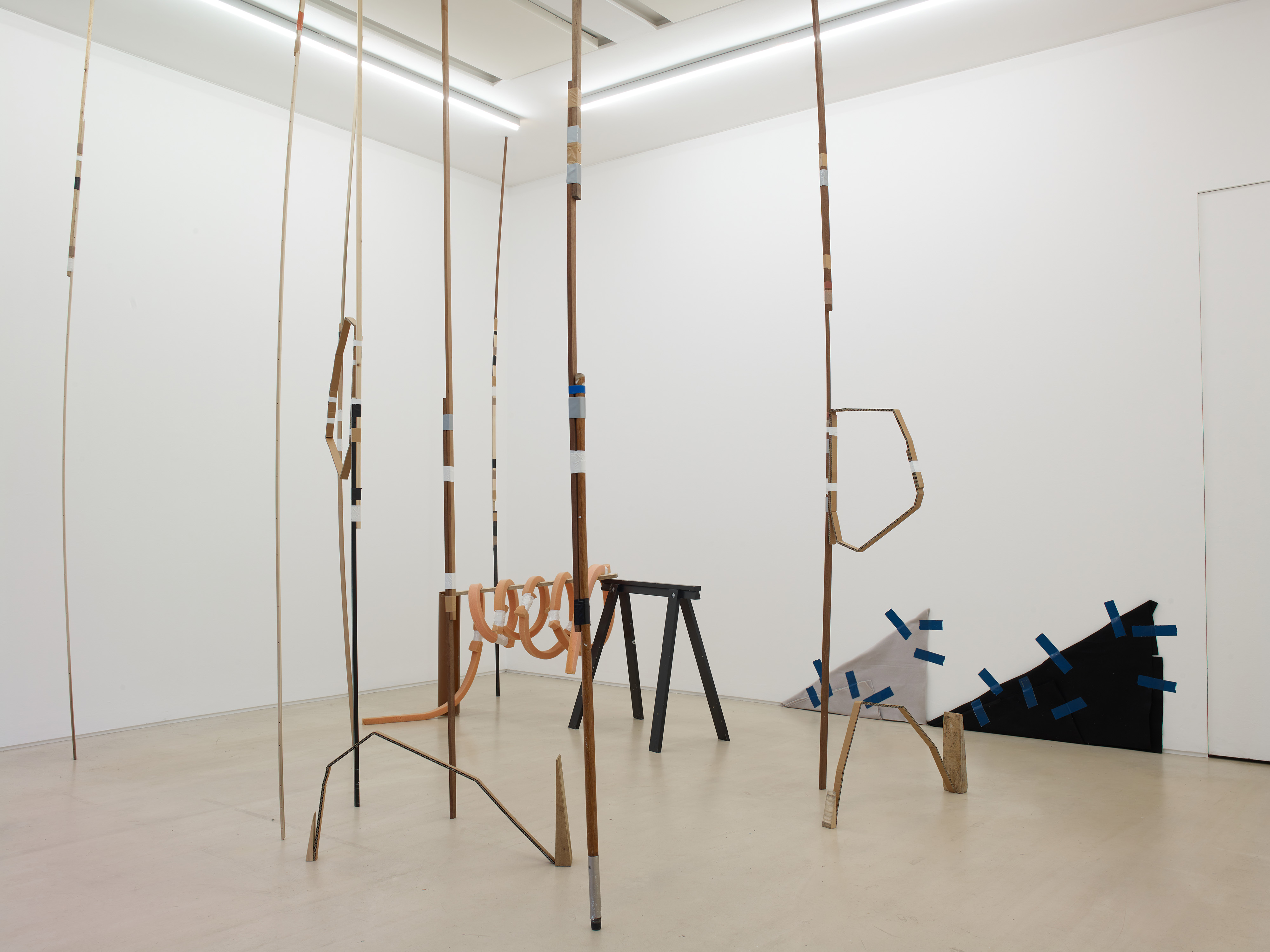
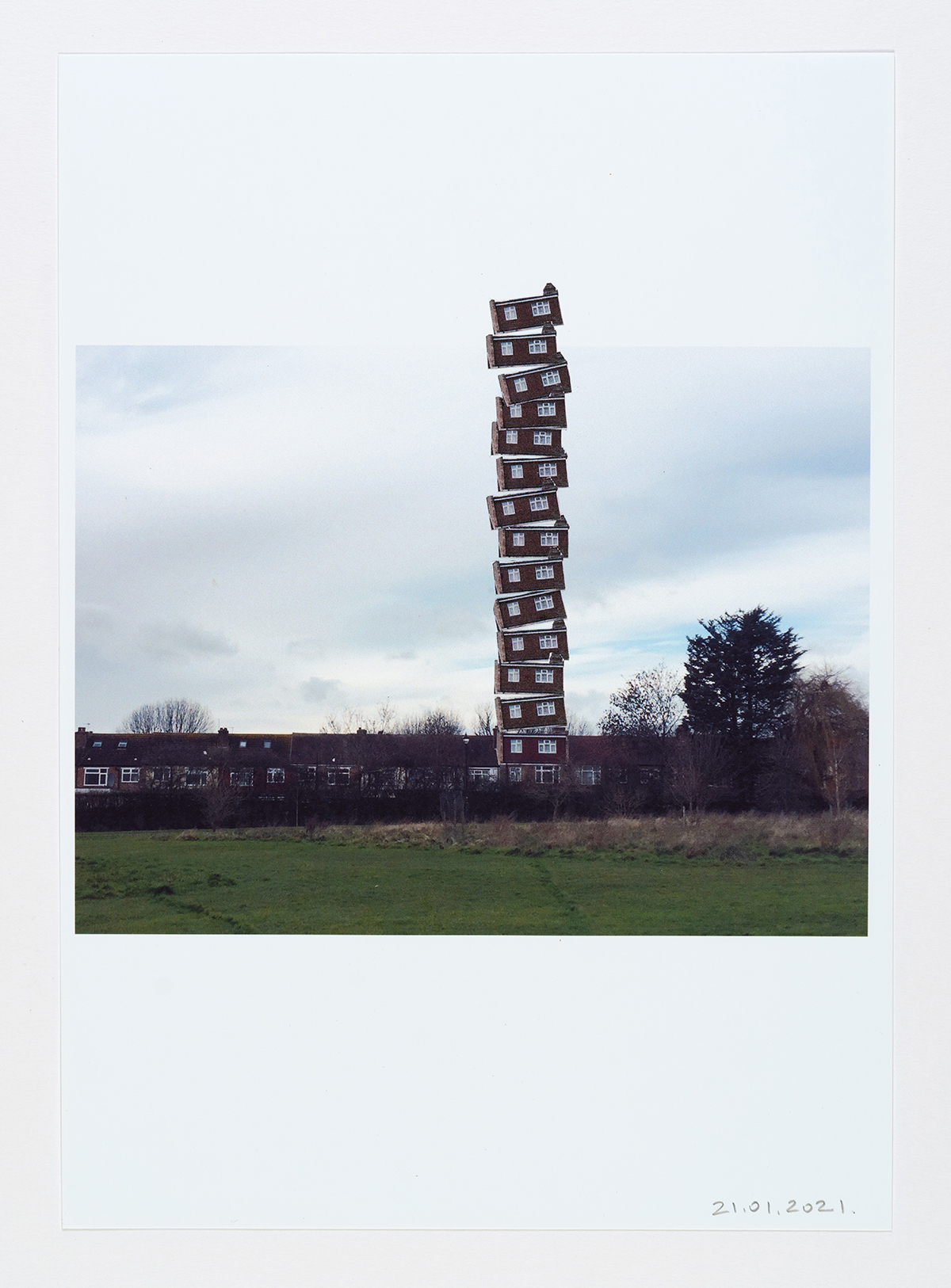
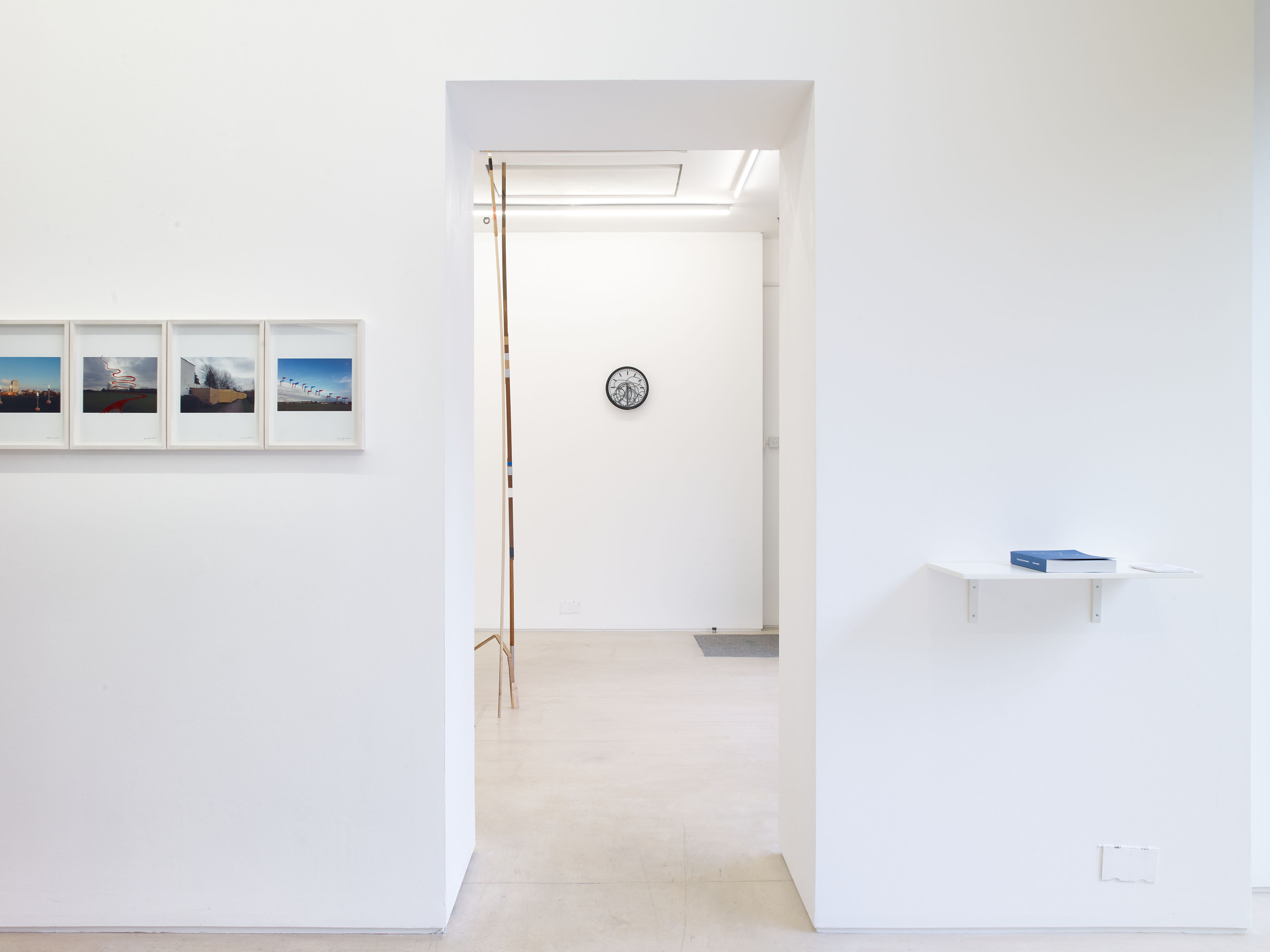

fig.xii-xv
Which is the space artists occupy.
We often think of architecture as a thing that's there in a very non-negotiable way, but it comes down very easily, it’s dismantled very easily, not only with decay, falling apart over time, but also deliberate acts of bringing it down - its solidity is just temporary.
In one of your collages you seem to trace the outline of buildings which aren't there, which look almost as if they are a planning application for towers showing height and shadowing.
Sometimes, on a very foggy day, I had that moment of, “is there a building there? Or not?” Sometimes things play tricks with your vision, and you're not sure what you're looking at. The work is then trying to amplify that feeling of ghostliness of buildings in the distance or fog. Both there and not there.
That’s something you play with in montage anyway. You declare there is a difference of images, you show the joint, it’s not like a smooth digital joining. But often images uncannily lock together.
It’s important to me it's not a seamless change, that the intervention is visible and looks self-declared, that there's a kind of fraughtness or tension between what's been done and what was there before. So the gesture wears its inadequacy or intervention on its sleeve, maybe inviting you to imagine how it was before.
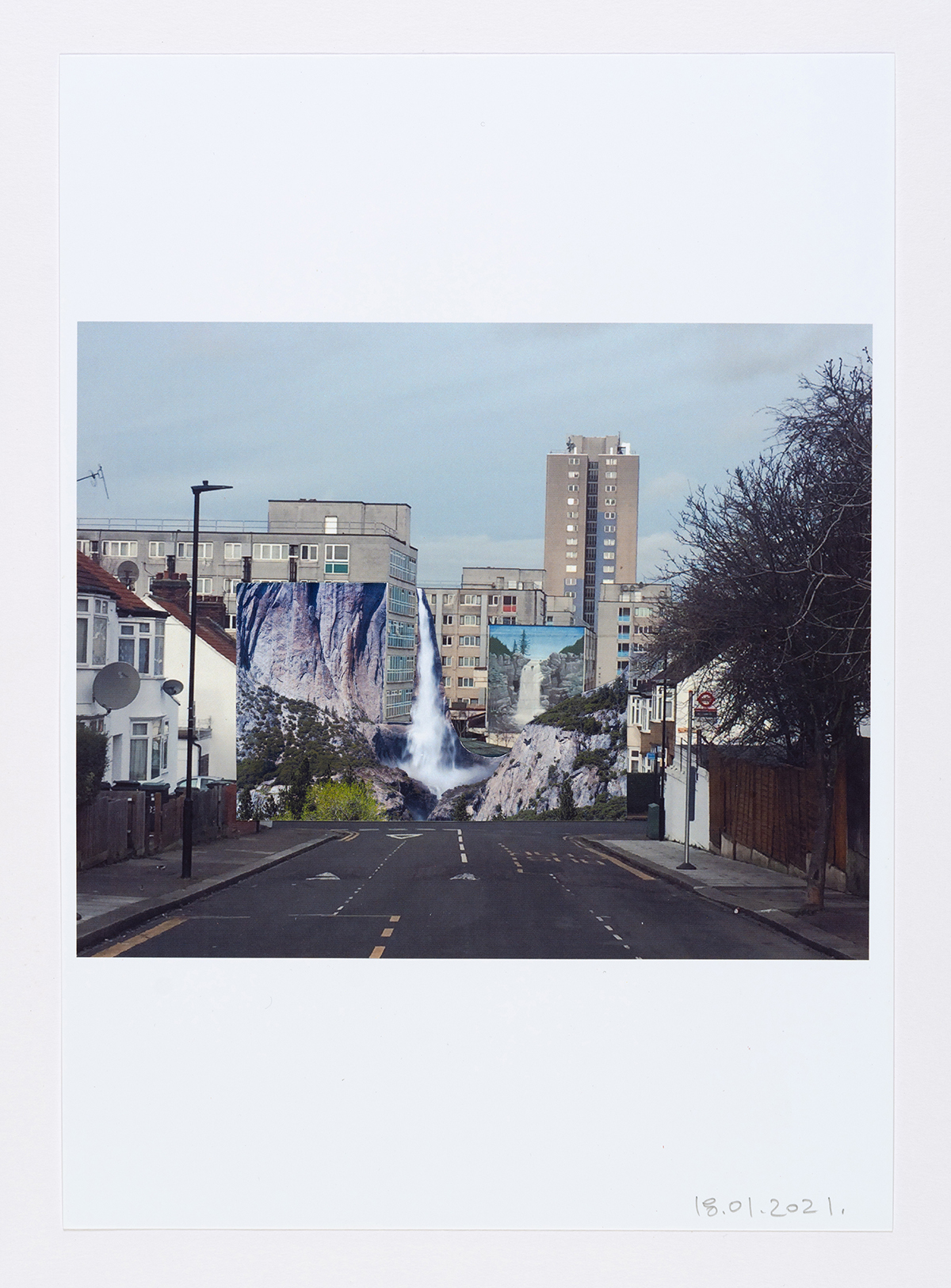

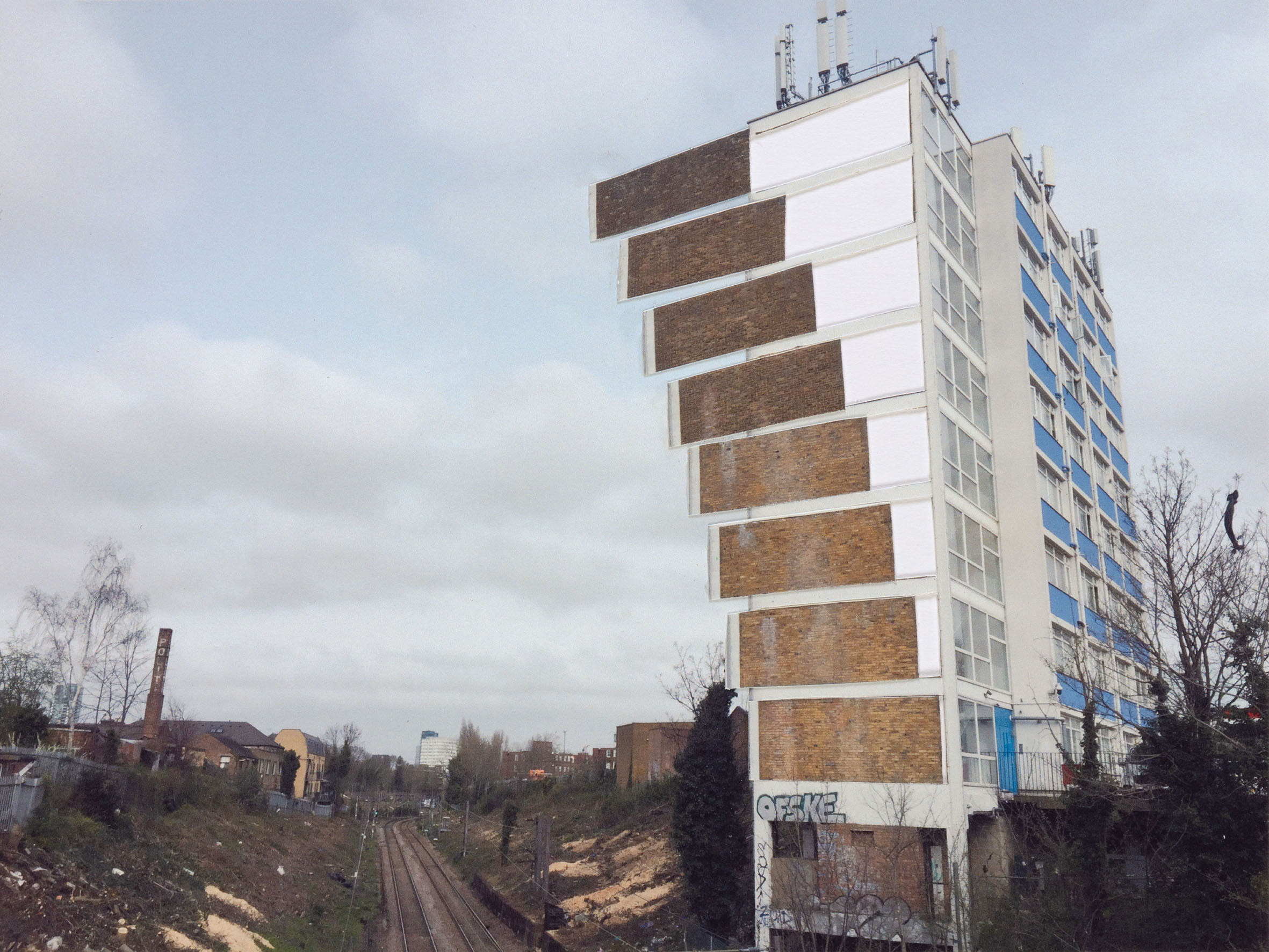

fig.xvi-xix
This is something relevant to architecture. In digital creation, anybody can come up with an idea for a building, and very quickly can create an immaculate render which looks real, like a photo. But often a sketch or model would be more truthful, opening up more opportunities.
Sometimes, on a very foggy day, I had that moment of, “is there a building there? Or not?” Sometimes things play tricks with your vision, and you're not sure what you're looking at. The work is then trying to amplify that feeling of ghostliness of buildings in the distance or fog. Both there and not there.
There are three parts to your exhibition – the photographic collages, sculpture, and video. How do you think they talk to each other?
The logic of the sculptural piece responds to the room. It's quite a tricky space in many ways, the windows dominate, and I wanted to make something which follows the logic of the collages, mirroring and repeating what is already there. So I use the windows to mirror in the room what is outside. Some of the structures are a kind of an inadequate attempt to remake what’s on the outside of the window – a bike lockup of metal loops, the verticals of trees and lampposts, a proliferation of cylindrical garbage cans. The starting point was again looking, but in this case looking outward, and trying to remake things.
So a translation from mundane physicality to art object.
From a real state to its representation, but a morphed and degraded one. In the same way there are two kinds of looking in the collages - looking in the world while walking, then looking into an image – there is something similar going on with an attempt to create a three dimensional image, an attempt to make a picture of what's outside.
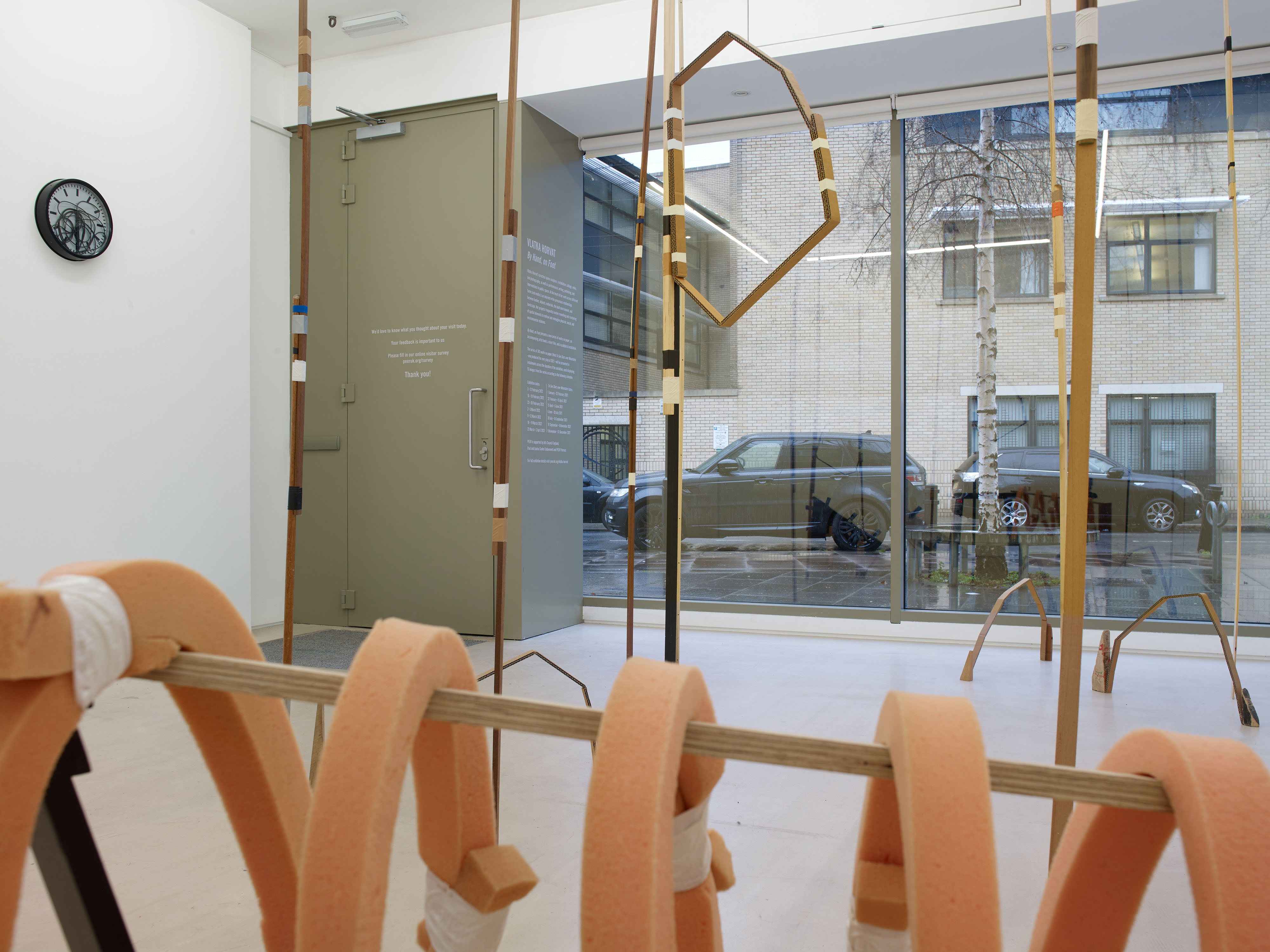
fig.xx
So, the opposite direction to how designers of the world work – they imagine something, draw it, then make it – whether building, object or street…
The installation started from looking at what's outside, but then forms repeat inside the room through proliferation or degradation. The starting point is trying to remake something I see, and then the forms produce their own logic which I follow. Maybe there's a searchfor something in this process, with repetition in general, when you do something over and over again.
There's something about escape. Your collages are trying to leave the frame, the sculptures seem like they are trying to push through the ceiling, and though we may love the streets or parks near our home, in lockdown we yearned for escape.
I think this is probably the case with any sort of repetition or routine that we have in the way we organise our lives, we like them - but also want to get away from them.


fig.xxi, xxii
Vlatka Horvat (b. Croatia, 1974) is an artist working across a wide range of forms, including sculpture, installation, drawing, performance, photography, video and writing. Her work is presented internationally in a variety of contexts – in museums and galleries, theatre and dance festivals, and in public space.
www.vlatkahorvat.com
PEER is an independent arts organisation that has evolved from the ground up over the past 20 years, putting down deep roots within the socially, culturally and economically diverse area of Hoxton in East London. PEER’s core ethos is to embed its activities into the local community and to offer and promote the highest quality art as being part of daily life. They have done this through their ambitious programme of projects working with nearly 150 artists, writers, curators and educators over two decades. They nurture and provide a platform for the talent of a diverse range of emerging, mid-career and established artists enabling them to take new risks. Past and recent examples include commissions with Martin Creed, Mike Nelson, Siobhan Hapaska, Anthony McCall, Bob & Roberta Smith, Fiona Banner, Danh Vo, Emma Hart, Jonathan Baldock, Jimmy Robert, Catherine Story, Jadé Fadojutimi, Olga Jevrić, Samson Kambalu, and Lubna Chowdhary.
www.peeruk.org
images
fig.i, ii Vlatka Horvat Installation at PEER, Photo
©
Stephen White and Co.
fig.iii To See Stars over Mountains, 2021, (13 February), © Vlatka Horvat.
fig.iv To See Stars over Mountains, 2021, (19 October),
© Vlatka Horvat.
fig.v To See Stars over Mountains, 2021, (08 October), © Vlatka Horvat.
fig.vi To See Stars over Mountains, 2021, (20 December), © Vlatka Horvat.
fig.vii To See Stars over Mountains, 2021, (08 December), © Vlatka Horvat.
fig.viii To See Stars over Mountains, 2021, (09 January), © Vlatka Horvat.
fig.ix To See Stars over Mountains, 2021, (26 March), © Vlatka Horvat.
fig.x Vlatka Horvat Installation at PEER, Photo ©Stephen White and Co.
fig.xi Until the Last of Our Labours is Done, 2021, film still © Vlatka Horvat.
fig.xii Vlatka Horvat Installation at PEER, Photo ©Stephen White and Co.
fig.xiii Around Here 11.51 am. Injet photo collage, series of 12 unique collages, £900 available from PEER. © Vlatka Horvat.
fig.xiv To See Stars over Mountains, 2021, (12 December), © Vlatka Horvat.
fig.xv Vlatka Horvat Installation at PEER, Photo ©Stephen White and Co.
fig.xvi To See Stars over Mountains, 2021, (14 January), © Vlatka Horvat.
fig.xvii
Around Here 11.58 am. Injet photo collage, series of 12 unique collages, £900 available from PEER. © Vlatka Horvat.
fig.xviii To See Stars over Mountains, 2021, (08 January), © Vlatka Horvat.
fig.xix To See Stars over Mountains, 2021, (13 April), © Vlatka Horvat.
fig.xx Vlatka Horvat Installation at PEER, Photo ©Stephen White and Co.
fig.xxi To See Stars over Mountains, 2021, (02 May), © Vlatka Horvat.
fig.xxii To See Stars over Mountains, 2021, (01 March), © Vlatka Horvat.
publication date
08 February 2022
tags
Architecture, Collage, Covid, Lockdown, London, Looking, Photography, Lauren Elkin, Vlatka Horvat, Interview, PEER Gallery, Georges Perec, Performance, Sculpture, Video
fig.iii To See Stars over Mountains, 2021, (13 February), © Vlatka Horvat.
fig.iv To See Stars over Mountains, 2021, (19 October), © Vlatka Horvat.
fig.v To See Stars over Mountains, 2021, (08 October), © Vlatka Horvat.
fig.vi To See Stars over Mountains, 2021, (20 December), © Vlatka Horvat.
fig.vii To See Stars over Mountains, 2021, (08 December), © Vlatka Horvat.
fig.viii To See Stars over Mountains, 2021, (09 January), © Vlatka Horvat.
fig.ix To See Stars over Mountains, 2021, (26 March), © Vlatka Horvat.
fig.x Vlatka Horvat Installation at PEER, Photo ©Stephen White and Co.
fig.xi Until the Last of Our Labours is Done, 2021, film still © Vlatka Horvat.
fig.xii Vlatka Horvat Installation at PEER, Photo ©Stephen White and Co.
fig.xiii Around Here 11.51 am. Injet photo collage, series of 12 unique collages, £900 available from PEER. © Vlatka Horvat.
fig.xiv To See Stars over Mountains, 2021, (12 December), © Vlatka Horvat.
fig.xv Vlatka Horvat Installation at PEER, Photo ©Stephen White and Co.
fig.xvi To See Stars over Mountains, 2021, (14 January), © Vlatka Horvat.
fig.xvii Around Here 11.58 am. Injet photo collage, series of 12 unique collages, £900 available from PEER. © Vlatka Horvat.
fig.xviii To See Stars over Mountains, 2021, (08 January), © Vlatka Horvat.
fig.xix To See Stars over Mountains, 2021, (13 April), © Vlatka Horvat.
fig.xx Vlatka Horvat Installation at PEER, Photo ©Stephen White and Co.
fig.xxi To See Stars over Mountains, 2021, (02 May), © Vlatka Horvat.
fig.xxii To See Stars over Mountains, 2021, (01 March), © Vlatka Horvat.
publication date
08 February 2022
tags
Architecture, Collage, Covid, Lockdown, London, Looking, Photography, Lauren Elkin, Vlatka Horvat, Interview, PEER Gallery, Georges Perec, Performance, Sculpture, Video


